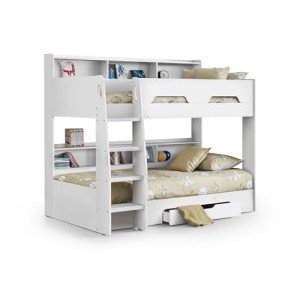Bunk Beds Sale: A Comprehensive Guide to Choosing the Right Bunk Bed for Your Home
Bunk beds have actually long been a staple in children's bed rooms, providing a mix of space-saving efficiency and enjoyable. Whether accommodating brother or sisters, buddies on pajama parties, or simply optimizing a playroom, bunk beds have become a necessary element in contemporary family homes. As sales on bunk beds increase, it ends up being progressively vital for customers to make informed choices when acquiring one. This short article will cover the essentials of purchasing a bunk bed, from types to safety functions, as well as tips for maintaining the stability of your financial investment.
Types of Bunk Beds
When considering a bunk bed sale (their explanation), it's crucial to understand the different styles readily available on the marketplace. Below are the most typical types:

Traditional Bunk Beds: These include two beds stacked one above the other, sharing a single frame. They are typically the most cost-effective option.
L-Shaped Bunk Beds: This style includes one bed placed vertically and another horizontally. This plan creates extra space below the upper bed, which can be utilized for storage or a backyard.
Lofted Beds: Similar to standard bunk beds however without any lower bed. Rather, the space below can be used for a desk, play location, or extra storage.
Triple Bunk Beds: For households with a larger variety of children or frequent pajama parties, triple bunk beds offer 3 sleeping locations in a space-efficient design.
Futon Bunk Beds: These designs merge bunk beds and futon sofas. The bottom section transforms into a separate seating location, enhancing functionality.
Convertible Bunk Beds: These beds can be separated into two individual beds, making them flexible as children's requirements change over time.
Table 1: Comparison of Bunk Bed Types
| Type | Description | Space Efficiency | Additional Features |
|---|---|---|---|
| Traditional Bunk Bed | Two beds stacked vertically | High | Easiest design |
| L-Shaped Bunk Bed | One vertical and one horizontal bed | Moderate | Play or storage space |
| Lofted Bed | Raised bed with open space listed below | High | Work/play location |
| Triple Bunk Bed | 3 stacked beds | Really High | Accommodates more users |
| Futon Bunk Bed | Bunk bed with a convertible futon | High | Multi-functional |
| Convertible Bunk Bed | Can be split into two separate beds | Moderate | Flexibility & & durability |
Safety Features to Consider
Security is vital when buying a bunk bed. Below are essential security functions to search for:
Guardrails: Adequate guardrails must be present on both sides of the upper bunk to avoid falls. They need to be at least 5 inches higher than the bed mattress.
Ladder Design: Look for tough, large ladders with slip-resistant rungs. Make sure that the angle is not too steep for easy gain access to.
Stability: Ensure the bed is constructed with strong materials, such as strong wood or sturdy metal. The bed needs to not wobble when in use.
Weight Limit: Check the weight capability of the bunk bed to ensure it can accommodate the designated users safely.
Product Safety: If possible, choose beds made from non-toxic products or those satisfying security requirements for kids's furnishings.
Table 2: Essential Safety Features
| Function | Description | Significance |
|---|---|---|
| Guardrails | Sides of upper bed to avoid falls | Vital for child safety |
| Ladder Design | Strong, slip-resistant rungs | Aids safe and easy access |
| Stability | Construct quality to prevent wobbling | Guarantees security and durability |
| Weight Limit | Maximum weight capacity | Avoids mishaps |
| Material Safety | Non-toxic, safe products | Protects children's health |
Maintenance Tips for Bunk Beds
To extend the life of your bunk bed and make sure ongoing security, consider the following maintenance tips:
Regular Inspections: Periodically inspect the structure for loose screws, bolts, or any signs of wear. Tighten fasteners as necessary.
Tidy Periodically: Dust and clean the surface areas frequently. Use appropriate cleaners that won't harm the surface.
Check Weight Limits: Be mindful of weight limits, especially with older children or adults who might wish to use the upper bunk.
Prevent Climbing on Guardrails: Educate kids not to use guardrails for climbing or playing to reduce the danger of mishaps.
Regularly Asked Questions (FAQs)
Q1: What is the age limit for children to safely utilize bunk beds?A: While it differs by the maker, lots of suggest that children under six should not sleep in the upper bunk due to safety concerns.
Q2: How can moms and dads discourage hazardous climbing?A: Setting clear guidelines about bunk bed use and supervising kids can assist. In addition, utilizing a bed tent can discourage climbing while creating an enjoyable sleep environment.
Q3: What should I think about when embellishing a room with bunk beds?A: Ensure there is adequate space around the bunk bed for safe movement, and use the decor to produce customized areas for each child.
Q4: Is a lofted bed ideal for older children?A: Yes, lofted beds can be ideal for older children as long as they fulfill security requirements and the kid is responsible enough to use them safely.
Bunk beds serve a functional function while including an aspect of fun to a child's bed room. As sales of bunk beds continue to rise, cautious factor to consider of types, safety functions, and upkeep practices is essential for moms and dads and caretakers. By understanding these important aspects, families can discover the best bunk bed for their home, ensuring both functionality and safety for several years to come. Whether it's for siblings sharing a space or developing a cozy sleepover space, a well-chosen bunk bed can supply happiness and usefulness, making it a worthwhile investment.



